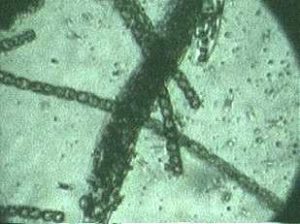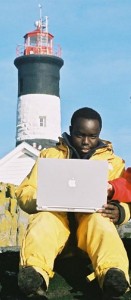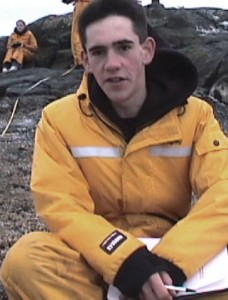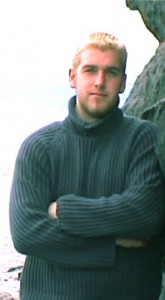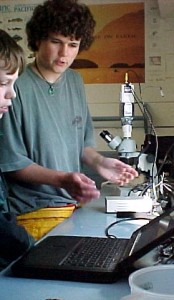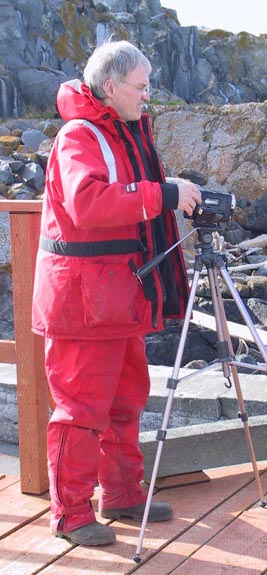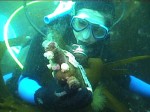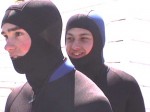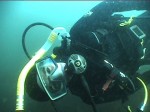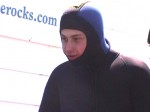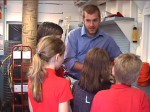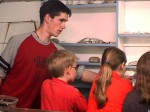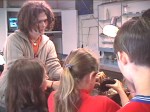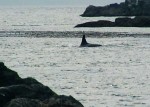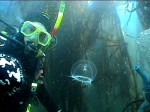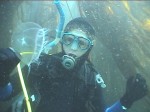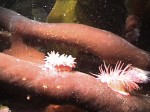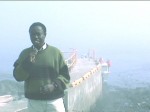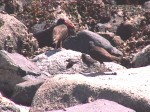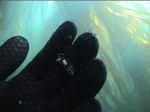This video is a compressed version of the one produced by Brainstorm for the Tidal Current Power Project. It documents the partners and the process along the way in the establishment of the Turbine Project . (released January 19, 2007 to correspond with the visit of Prime Minister Stephen Harper to Lester Pearson College and Race Rocks. )
Category Archives: Scenes – Activities Video
David Grierson broadcasts CBC radio from Race Rocks
On June 8, 2004, we were fortunate to have David Grierson doing the CBC morning show
“On The Island ” broadcast live from Race Rocks.
We were saddened to hear of his death from a heart attack in November of 2004.
Tidepool Studies at Race Rocks Pool #4 Peg6
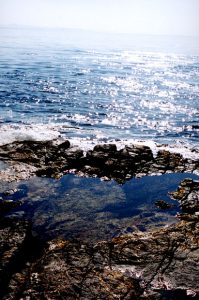 A general view of the pool.It is perched on a shelf which easily gets flooded when there is a slight swell in the ocean. A general view of the pool.It is perched on a shelf which easily gets flooded when there is a slight swell in the ocean. |
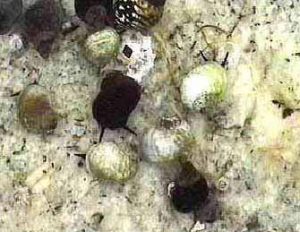 Polymorphism in the Snails of Pool # 4, Extended essay in Environmental Systems, Polymorphism in the Snails of Pool # 4, Extended essay in Environmental Systems, |
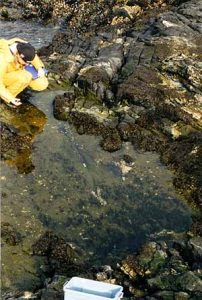 A student examines the life of pool 4 A student examines the life of pool 4 |
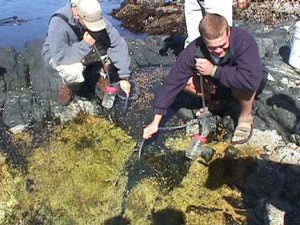 A A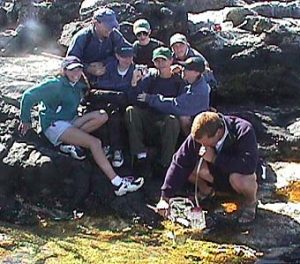 mphipods collected with a suction bottle from pool#4. mphipods collected with a suction bottle from pool#4. |
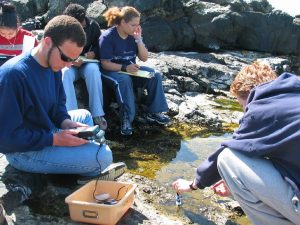 Roberto and the Biology Class measure salinity in pool 4.. May 2004 Roberto and the Biology Class measure salinity in pool 4.. May 2004 |
|
 Enteromorpha growing in the pool. May 2004. Enteromorpha growing in the pool. May 2004. |
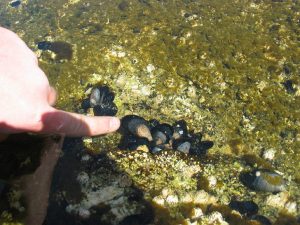 Bay mussels, Mytilus trossulus in the brackish water of Pool#4 Bay mussels, Mytilus trossulus in the brackish water of Pool#4 |
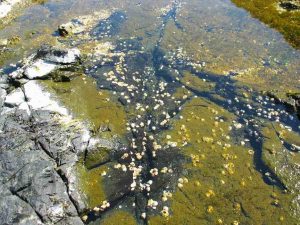 In May 2004,it is clear where the grazers, Littorina snails and amphipods) have trimmed off the diatoms on the bottom. In May 2004,it is clear where the grazers, Littorina snails and amphipods) have trimmed off the diatoms on the bottom. |
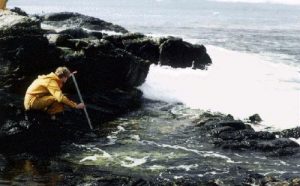 Arunas measures the depth of pool 4 while watching for swells Arunas measures the depth of pool 4 while watching for swells |
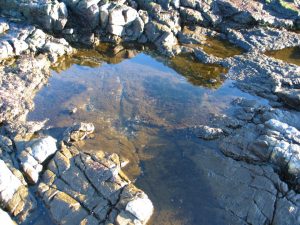 In February, 2007, the diatoms cover almost the entire bottom of the pool. This is the winter pattern. Grazing as shown above gradually removes the covering of diatoms. In February, 2007, the diatoms cover almost the entire bottom of the pool. This is the winter pattern. Grazing as shown above gradually removes the covering of diatoms.
|
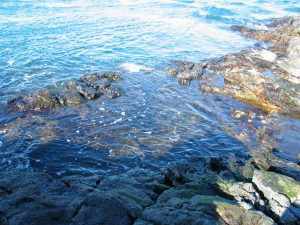 January, 2007. The tide is at its peak today, showing pool 4 being entirely submerged. January, 2007. The tide is at its peak today, showing pool 4 being entirely submerged. |
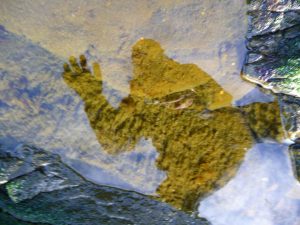 On February 11, 2008 a beast is photographed in the tidepool. On February 11, 2008 a beast is photographed in the tidepool. |
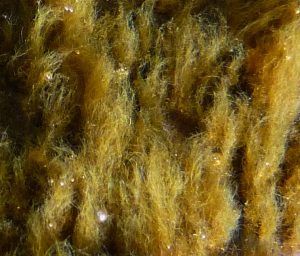 Close up of the Filamentous golden algae filling the tidepools in early spring. Close up of the Filamentous golden algae filling the tidepools in early spring. |
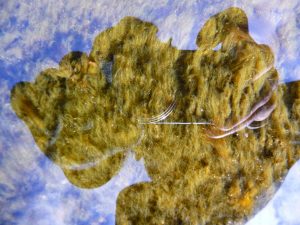 Weird form shades a covering of diatom fuzz! Weird form shades a covering of diatom fuzz! |
Some ideas to consider:
Invitations to Inquiry:
This pool is unique in a number of ways. The white substrate in the bottom of the pool is the result of a quartz intrusion that has flooded while molten, through the cracks of the basalt.
What is the effect of this white reflective surface on the temperature of the pool and the organisms that live in the pool?In 1997 while doing a detailed analysis of the organisms in the pool, we noticed for the first time that there were white periwinkles. At that time 26 were counted by Nadia and Catherine. Speculate on the evolutionary implications here.
The mussels in pool #4 are Mytilus trossulus, the bay mussel. Mussels that you can see on the surrounding intertidal areas are the Mytilus californianis. Why the species difference?
The pattern of diatom distribution changes in the bottom of the pool. In the winter, it covers the pool with a thick felt-like appearance, as spring approaches, the cover of diatoms starts to disappear, starting along the cracks where the mussels are anchored.. could one measure the rate of grazing from the amphipods in the cracks?
Temperature and Salinity in the pool fluctuate widely and at times form stratified layers. How does this affect organism distribution.?
The biotic and abiotic features of this pool vary considerably from other pools in the near vicinity. Quantify and explain the differences or similarities.
The only other pool that resembles this one is found over on the north-east corner of the island, at location peg15-pool #14. Compare the biotic and abiotic factors of these two pools, and explain the differences.
The following lab on tidepool abiotic factor measurement was done by Chiara Ravetti in September,2005.
Biology Laboratory
Analysis of the Abiotic Factors in Race Rocks Tidepools
The measurements of salinity, ph, and temperatures of different tidepools at Race Rocks was done September19, after 11.30 a.m., with high tide. For this reason the pools selected were only five, two (pool 7 and 8) several meters away from the sea at that time of the day, the other three (pool 1, 2 and 4) closer to the water and larger.
Data analysis and further note
| pool 1 | pool 2 | pool 4 | pool 7 | pool 8 | Ocean water | |
| Salinity | 62.1 | 32.8 | 21.9 | 45.3 | 45 | 30 |
| Temperature | 14.4 C | 14.4 | 14.2 | 15.4 | 15.2 | 10 |
| ph | 8 | 6.8 | 6.9 | 7 | 8 | — |
The measurement of salinity is expressed in parts per thousand; the instrument utilizes electricity, that passing through salt ions determines its quantity.
The pools were contaminated by sealions excrement, which reduced the visibility inside the pool and probably altered the pH of the water.
Other factors which might affect these values in a tidepool are: evaporation, precipitation, and in general pollution, scarce precipitation at that time of the year, the presence of the estuary, (The Strait of Juan de Fuca) with the influence of fresh water. The salinity in a tidepool is higher than the sea, for the evaporation and the little exchange of water, therefore the organisms living in it must tolerate high salinity, as well as variations in temperature. The smaller tidepools further from the sea present even more significant changes.
Tidal Cycle at Race Rocks Video
This clip was produced on 8.11.2002. As Race Rocks Marine Protected Area is a place where large (3 meter) tidal range occurs, it is a good location to observe the raising and lowering of the water . A rock in Race Passage near the West shore of Great Race Rock was chosen and a camera was installed in front of the window of the research room in the Marine Science Centre. Video clips were taken for 15 seconds every hour of daylight, high tide occurred during noontime. The second part of the clip shows the tide going in fast motion, a day at the rock passes in 25 seconds.” Jeremias Prassti, ( PC yr 28)
From Victoria Tide tables for this date.. 8.11.2002. :
time… tidal height (ft)………….(meters)
0910 …………………..8.9……………..2.7
1100………………….. 8.5……………..2.6
1445………………….. 9.2……………..2.8
2345………………….. 1.0………………0.3
PROJECT IDEA:
1. On graph paper, using the data above, plot the tidal variation for the day. Then pause the video on each of the levels, measure the height of an exposed piece of the rock and then plot it on the graph. In this way you should be able to determine the elevation of the top of the rock.
2. Link to the physical factor page for Race Rocks – Go to the Tidal calculator links available and compare the shape of the graph for November 8, 2002 with the graph you have made here
The Johan Ashuvud Race Rocks 2002 Project- Video by Ben
Ben Dougall (PC yr.28) from Australia has edited this clip demonstrating some of the highlights of his stay with “The Crew” at Race Rocks.They were there for the Johan Ashuvud Race Rocks02 Project in the first two weeks of June 2002 . As well as providing daily webcasts from the mobile camera, they took over the duties of the Ecological reserve ecoguardians and worked on producing a number of video sequences for the video archives and Race Rocks Taxonomy.
Go to “MEET THE CREW” for the Project.
Webcasting Crew at Race Rocks for the Johan Ashvud RR’02 Project
MEET THE CREW:
| — |
“We had a great time webcasting live from Race Rocks on Camera 4 during the first two weeks of June for the Johan Ashuvud Race Rocks02 Project”
Three current first year students from Pearson College and Ryan Murphy, who graduated last year stayed at the Marine Science Centre. Ryan is returning to Race Rocks this month to do research for Mt.Allison Univ. on the macroalgal community.
See one video on Pterygophora which was one part of his project here: They conducted daily live and prerecorded webcasts with Garry Fletcher from the intertidal and from underwater using camera 4.
For one of the webcasts we were joined by Sean LeRoy, Graduate Researcher, Georgia Basin Futures Project Sustainable Development Research Institute, University of British Columbia and Dr.James Tansey also of UBC. They came to participate in the webcast with Garry and Ryan on Marine Protected Areas in new Zealand and Canada with Tim Langlois, Leigh Marine Laboratory University of Auckland, and Anne Saloman, University of Washington, Zoology Department.
On three days we hosted small groups of students from local elementary schools who served as proxies in webcasts done for their classmates.
Support for the Race Rocks 02 Project came from the Johan Ashuvud Race Rocks Memorial Fund
Below are some of the Videos produced by the crew during the week.
 |
 |
 |
| Ben’s movie put together during the week. | June 2002 field trip: for a live webcast with the crew, of the grade six students from West-Mont school . | One morning we found the body of an octopus washed up in the intertidal zone. An impromptu dissection led to this video. |
- Ryan with a bottle on one of his many dives studying macroalgae that week.
- Joe and Jedrzej prepare for a dive .
- Joe just doing his thing??
- Jedrzej
- Ben discusses the black Oystercatcher food web with the Grade six students of West-Mont School
- Joe and the students from West-Mont School
- Ryan demonstrates the escape response of the abalone.
- We did three live webcasts with visiting school groups ( see video above)
- One of our Orca visitors that week filmed by Ben.
- Joe contemplating a medusa.
- In this clip from a video taken by Jedrzej, Ryan also encounters the medusa.
- Michael Kiprop announcing the morning webcast live on camera 4.
- The 4 Black oystercatcher families which have successfully hatched, can be seen frequently feeding with their chicks in the low intertidal zone.
- We finally found out this creature was..Euphysa It was filmed by Jedrzej as it drifted with the plankton.
Sunset on Race Rocks Video
Race Rocks, with its location in the Strait Juan de Fuca, often gets illuminated in the evening by sunsets such as this one. It adds to the beauty of the site and reminds one of the importance of protecting such a place. In this video, the Pearson College Choir accompanies the video with the singing of the ‘Skidigate Love Song’. This video was made and edited by Jean-Olivier Dalphond (PC 26) in June 2001.
Saltwater Images of Race Rocks and music of Holly Arntzen
When Race Rocks was declared Canada’s first Marine Protected Area, Holly Arntzen offered Pearson College the opportunity to use some of her songs as video backgrounds. Her CD entitled “The Salish Sea” is about the fading beauties of the oceans and it stresses the importance of their protection.
Using the song “Saltwater” as a background, this video shows images of divers and the bull kelp, Nereocystis leutkeana, a species of brown algae present in high density throughout the summer and fall at Race Rocks. Their lamina provide a special protective canopy for a delicate ecosystem with many species of invertebrates and fish under their canopy. This video was filmed and edited by Jean-Olivier Dalphond (PC yr26) and Damien Guihen (PC yr27) in June 2001.
Coast Guard Helicopter replaces Generator
For maintenance purposes, the Canadian Coast Guard is replacing one of the generators necessary to power Race Rocks. This piece of equipment is a 25kW Diesel generator located in the engine room situated in the southern part of the island. Hopefully, in the next decade, we will be able to switch to renewable energy to move a step further toward our goal of sustainability for the islands and protection of the environment.
This video was made by Ryan Murphy and Paulina Ponce de Leon in October of 2000
Environmental Systems Field Exam 2000
The end of term exam in the first year environmental systems class is always held at Race Rocks. These images were taken as the students worked at the various stations on the island in mid-May of 2000.

